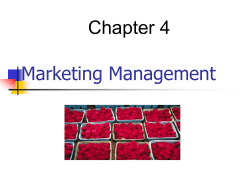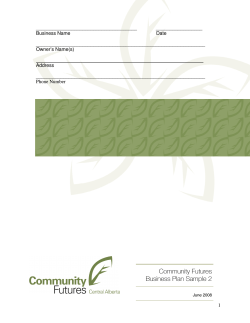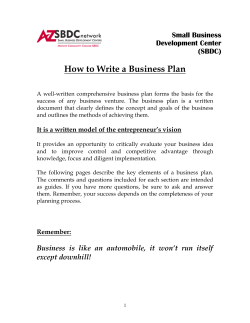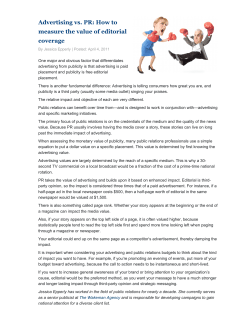
Elements of the Promotion Mix Ingredients of the Promotion
Elements of the Promotion Mix Advertising Ingredients of the Promotion Mix Public Relations Personal Selling Sales Promotion The Communication Process Noise Sender Encoding Channel Channel Decoding Receiver Goals and Tasks of Promotion Informing Reminding Target Audience Persuading AIDA and the Hierarchy of Effects Purchase Conviction Preference Liking Knowledge Awareness Attention Interest Desire Action When Elements of Promotion Are Most Useful Effectiveness Advertising Personal selling Sales promotion Public relations Awareness Knowledge Liking Preference Very effective Somewhat effective Either not effective or inefficient Conviction Purchase Factors that Affect the Promotion Mix Nature of the Product Stage in the Product Life Cycle Target Market Characteristics Type of Buying Decision Available Funds Push–and–Pull Strategies $$$ Creating a Promotion Plan Analyze the Marketplace Identify Target Market Set Promotion Objectives Develop Promotion Budget Choose Promotion Mix Criteria for Setting Promotion Objectives Promotion objectives should: be measurable, concrete be based on sound research, with a well-defined target audience be realistic reinforce the overall marketing plan and relate to specific marketing objectives Examples of Promotion Objectives Objective: To Inform (Awareness) To increase the top-of-mind awareness level for Peter Pan peanut butter from 16 percent to 24 percent Objective: To Persuade (Attitudinal) To increase the percentage of parents who feel that Peter Pan peanut butter is the best peanut butter for their children from 22 percent to 35 percent Objective: To Remind To remind consumers that Peter Pan peanut butter is the creamiest peanut butter and is available at their nearest grocery and convenience stores Techniques for Setting Promotion Budgets • Arbitrary Allocation • All - You - Can - Afford • Competitive Parity • Percent of Sales • Market Share • Objective and Task Regulation of Promotion Self-Regulation • National Advertising Division (NAD) • National Advertising Review Board (NARB) Federal Regulation • Federal Trade Commission (FTC) Return on Advertising Expenditures Effects of Advertising Diminishing returns on additional spending Increasing efficiency as ad budget becomes sufficient Advertising Spending Major Types of Advertising Corporate Image Institutional Advertising Advocacy Advertising Types of Advertising Pioneering Product Advertising Competitive Comparative Advertising Campaign Decision Process Determine the campaign objectives. Make creative decisions. Make media decisions. Evaluate the campaign. Common Advertising Appeals Profit Save money, keep from losing money Health Body-conscious, healthy Love or Romance Sell cosmetics and perfumes Fear Social embarrassment, growing old, losing health, power Admiration Celebrity endorsement effective Convenience Fast-food and microwave products Fun and Pleasure Vacations, beer, amusement parks Vanity and Egotism Expensive, conspicuous items Executional Styles for Advertising Scientific Slice-of-Life Musical Demonstration Mood or Image Lifestyle Common Executional Styles Spokesperson/ Testimonial Fantasy Real/ Animated Product Symbols Humorous Methods Used to Evaluate Advertising Campaigns Pretests Examples: • Consumer jury tests • Portfolio or unfinished rough tests • Physiological tests Post-tests Examples: • Recognition tests • Recall tests • Attitude measures • Audience size measurement The Tools of Public Relations New Product Publicity Product Placement Major Tools Used By PR Professionals Customer Satisfaction Phone Lines Consumer Education Event Sponsorship Issue Sponsorship Web Sites Types of Consumer & Sales Promotion Goals Type of buyer Desired results Loyal customers People who buy your product most or all of the time Reinforce behavior, • Loyalty marketing programs, increase consumption, such as frequent-buyer cards change purchase timing or frequent-shopper clubs • Bonus packs that give loyal consumers an incentive to stock up or premiums offered in return for proofs-of-purchase Break loyalty, persuade •Sampling to introduce your to switch to your brand product’s superior qualities compared to their brand • Sweepstakes, contests, or premiums that create interest in the product Persuade to buy your • Any promotion that lowers the brand more often price of the product, such as coupons, price-off packages, and bonus packs • Trade deals that help make the product more readily available than competing products Appeal with low prices • Coupons, price-off packages, or supply added value refunds, or trade deals that that makes price less reduce the price of brand to important match that of the brand that would have been purchased Competitor’s customers People who buy a competitor’s product most or all of the time Brand switchers People who buy a variety of products in the category Price buyers People who consistently buy the least expensive brand Sales promotion examples Source: From Sales Promotion Essentials, 2E by Don. E. Schultz, William A. Robinson, and Lisa A. Petrison. Reprinted by permission of NTC Publishing Group, Lincolnwood, IL. Tools for Consumer Sales Promotion Coupons Premiums Six Categories of Consumer Sales Promotions Frequent Buyer Programs Contests and Sweepstakes Samples Point-of-Purchase Displays Tools for Trade Sales Promotion Trade Allowances Push Money Training Free Merchandise Store Demonstrations Business Meetings, Conventions, Trade-Shows Six Categories of Trade Sales Promotions Advantages of Personal Selling Detailed Information Message Control Targeted Cost Control Closing Sales Advertising Versus Personal Selling Personal Selling is more important if... The product has a high value. It is a custom-made product. There are few customers. The product is technically complex. Customers are geographically concentrated. Advertising/Sales Promotion is more important if... The product has a low value. It is a standardized product. There are many customers. The product is simple to understand. Customers are geographically dispersed. Differences Between Traditional & Relationship Selling Traditional Personal Selling Relationship Selling Sell products (goods and services) Sell advice, assistance, and counsel Focus on closing sales Focus on improving the customer’s bottom line Limited sales planning Considers sales planning as top priority Spend most contact time telling customers about product Spend most contact time attempting to build a problem-solving environment with the customer Conduct “product-specific” needs assessment Conduct discovery in the full scope of the customer’s operations “Lone-wolf” approach to the account Team approach to the account Proposals and presentations based on pricing and product features Proposals and presentations based on profit impact and strategic benefits to the customer Sales follow-up focused on product delivery Sales follow-up is long term, focused on long-term relationship enhancement Source: Robert M. Peterson, Patrick L. Shul, and George H. Lucas, Jr., “Consultative Selling: Walking the Walk in the New Selling Environment,” National Conference on Sales Management, Proceedings, March 1996. Steps in the Selling Process Generating Sales Leads Qualifying Sales Leads Basic Steps in the Selling Process Making the Sales Approach Making the Sales Presentation Handling Objections Closing the Sale Following Up Functions of Sales Management Set Sales Objectives Evaluate Sales Force Manage Turnover Structure Sales Force Major Tasks of Sales Management Determine Sales Force Size Develop Compensation Plan Motivate Sales Force Train Sales Force Recruit Sales Force Cost Determinants of Price 200 Dollars 150 MC ATC AVC 100 50 AFC 0 1 2 3 4 5 Quantity 6 7 8 9 10 Break-Even Analysis Total Revenue Break Even Profits Price ($) Total Costs Fixed Costs Losses Quantity (units) Steps in Setting the Right Price Establish Pricing Goals Estimate Demand, Costs, and Profits Choose Strategy Fine-Tune Base Price $ $ $Right $ Price $$$$ Legal and Ethical Issues in Pricing Unfair Trade Practices Key Legal and Ethical Issues Related to Price Price Fixing Price Discrimination Predatory Pricing Discounts, Allowances, and Rebates Cash Discount EDLP Quantity Discount Seasonal Discounts Price Reductions Functional Discount Promotional Allowances Trade Loading Rebates Geographic Pricing FOB Origin Uniform Delivered Pricing Tactics Based on Geography Zone Pricing Freight-Absorption Basing-Point Special Pricing Tactics Single Price Two-Part Pricing Bundle Pricing Flexible Pricing Common Special Pricing Tactics Odd-Even Pricing Professional Services Price Lining Bait Pricing Leader Pricing
© Copyright 2025











